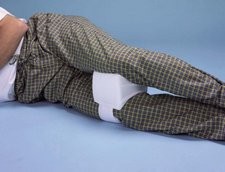- Providing Helpful Healthcare Products Since 1999 | Our Hours: 8 AM - 5 PM CST Mon - Fri
- +1-877-750-0376
Bed Positioning And Limited Mobility
New & Featured Items for July 2015
July 8, 2015Bed Positioning And Limited Mobility Round 2
July 11, 2015There are many conditions that cause people not to be able to move at all or almost at all, and this means positioning in bed must be done with detail in mind. Here, gravity plays a key role.
Those of us (this author included) who have muscle atrophy or are paralyzed know exactly what this feeling of “dead weight” entails when being cared for. We are not able to move on our own enough to reposition ourselves, whether in bed or in the chair. This limited mobility also comes into play when a caregiver is helping get dressed, showered or transferred.
In these situations, being conscious of the laws of gravity is extremely important for the safety and tranquility of the one being cared for.
If you are a caregiver, you are probably aware of some of the standard bed positioning practices — draw sheets, lateral supports, leg alignment, back alignment, underarm support, etc. Let’s take a look at some realities you probably haven’t thought about in regards to bed positioning of someone with very limited or absent range of motion.
Draw sheets
When you turn patients in bed, they may be able to “work with you” by rolling over partially on their own, and you might not have even realized this.
However, patients who cannot move very much will not be able to work with you. Therefore, you need to have a system for turning them in place in the bed. The words “in place” in that sentence are important. Otherwise, when you turn them, they will not be lying in the middle of the bed but rather on the very edge of the bed or, worse, on the floor!
Draw sheets are often used for this purpose. If your patient or loved one uses a draw sheet, be sure it is properly placed. It must be under their shoulders and pelvis in order to effect a balanced turn. If the draw sheet is too short to fit under their shoulders, for instance, you will only rotate their hips and painfully twist their back. Consider refolding the draw sheet to make it longer.
Leg alignment
The textbook way to handle leg alignment when someone is lying on their side is to put a pillow between their legs, including the knees and ankles.
It is a good strategy, but keep in mind that pillows are tricky. When someone can’t move well on their own, ask them what fine tuning needs to be done. If there is more cushion between the ankles than the knees, for instance, this could cause the knee to be angled inward and cause knee pain in the morning.
Underarm support
When the patient is lying on their side, another textbook technique is to place a pillow under whichever arm is on top.
This is good because it keeps the shoulder from drooping and aching. However, also be mindful of how this affects the hand, which may be resting in an uncomfortable, doubled-under position on the bed.
We’ll look at some more tips on this topic in a future post. Until then, think about these things while you look for bed positioning aids. Click here to check out all the bed positioning aids in our store. If you think one of our aids will work for your situation, we’d love to hear your feedback!


